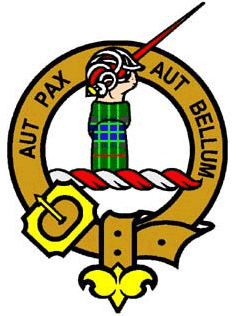Gunn Clan
Gunn Clan Crest: An arm attired in the Gunn tartan with the hand grasping a basket hilt sword.
Gunn Clan Motto: Aut Pax Aut Bellum (Either peace or war).
Gunn Clan History
The Gunns are of Viking descent through the marriage of Gunni, grandson of Sweyn Asleifsson, and Ragnhild, a descendant of St Ragnavald, who built St Magnus Cathedral in Kirkwall, on Orkney. Clan Gunn occupied
the northern areas of Caithness and Sutherland and were sworn enemies of Clan Keith.
Several battles took place over the 15th century, at Harpsdale in 1426, at Tannach Moor in 1438, and at Dirlot in 1464. Eventually it was decided that a peace should be struck and the two Chiefs agreed to meet at
the Chapel of St Tears, near the Gunn stronghold of Ackergill Castle, each bringing with them twelve horses. However, the Keiths appeared with two clansmen on each horse and the Gunns were outnumbered two-to-one.
The Gunn chief and four of his sons were killed, and to avenge this, James Gunn, the surviving son, later killed the Keith chief and his son at their castle of Ackergill. This brought the Earls of Caithness and Sutherland
into the dispute and there were heavy losses on both sides. By 1594 the Gunns were being listed as one of the 'broken clans' of the North.
In 1978, the Earl of Kintore, Chief of Clan Keith, and Iain Gunn of Banniskirk, Commander of the Clan Gunn, signed a Treaty of Friendship between the two Clans at the site of the Chapel, thus bringing to an end a five hundred year old feud.
The Gunns of Killearnan married twice into the family of Lord Reay, Chief of Clan Mackay, but in a later generation their lands were lost through debt. Sir William Gunn (1603-1661), a younger son of the Braemor branch, known as the 'Robson Gunns,' became a General in the Holy Roman Empire. A Sir James Gunn is believed to have accompanied Prince Henry St Clair of Orkney on his epic voyage to Estotiland (later known as Nova Scotia) in 1398.
Neil Gunn (1891-1971) wrote many successful novels including The Silver Darlings in 1951. Sir James Gunn (1893-1965) became President of the Royal Society of Portrait Painters in 1953. Sir William Gunn (1914-2003 ) was instrumental in the development of the first modern techniques for wool promotion in Australia.
In the 18th and 19th centuries, as tenants of the Sutherland estates, many of the members of Clan Gunn emigrated to Canada and New Zealand.
In 1785, the last chief, Morrison Gunn, the 9th Mackeamish, was killed in action without issue and the Clan would wait another 230 years for their next leader, when, in 2015, The Lord Lyon King of Arms recognised Iain Alexander Gunn of Banniskirk as the new chief of Clan Gunn.
Places of Interest:
Clan Gunn Heritage Centre and Museum, Latheron, Caithness. Clyth Castle, East of Lybster, Thurso, Caithness. Earliest of all known Clan Gunn strongholds, now destroyed. Halberry Castle, Lybster, Caithness. Ruined
stronghold of George Gunn, 7th Chieftain of the Clan Gunn.
Surname distribution in Scotland: The highest instances of the Gunn name occur in Highland (particularly in Caithness), The Outer Hebrides, Edinburgh City and the Lothians ( includes the historic counties of Linlithgowshire, Edinburghshire and Haddingtonshire).
Associated family names (Septs): Enrick, Galdie, Gallie, Ganson, Gaunson, Georgeson, Henderson, Inrig, Jameson, Jamieson, Johnson, Kean, Keene, MacComas, MacCorkill, MacCorkle, MacCullie, MacIan, MacKames, MacKeamish, MacKean, MacMains, MacManus, MacOmish, MacRob, MacWilliam, Magnus, Main, Mann, Manson, Neilson, Nelson, Robinson, Robison, Robson, Ronald, Ronaldson, Sandison, Swan, Swann, Swanney, Swanson, Will, Williamson, Wills, Wilson, Wylie, Wyllie.

